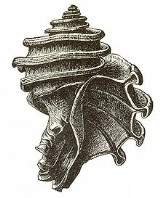
Ecphora gardnerae gardnerae
Encyclopedia
Ecphora gardnerae is a species
of fossil
predatory sea snail
, an extinct marine
gastropod mollusk in the family Muricidae
, the rock snails.
epoch
, and became extinct more than five million years ago. The shells are found as fossils in Maryland
and Virginia
.
This species was previously known as Ecphora quadricostata, but that name is now restricted to a Pliocene
species which is found from Virginia to Florida.
The Miocene species found in Maryland has been assigned to a different taxon, Ecphora gardnerae.
.
State Fossil
, Ecphora quadricostata was invalid (quadricostata is not actually found in Maryland) and needed to be changed to Ecphora gardnerae gardnerae.
Species
In biology, a species is one of the basic units of biological classification and a taxonomic rank. A species is often defined as a group of organisms capable of interbreeding and producing fertile offspring. While in many cases this definition is adequate, more precise or differing measures are...
of fossil
Fossil
Fossils are the preserved remains or traces of animals , plants, and other organisms from the remote past...
predatory sea snail
Snail
Snail is a common name applied to most of the members of the molluscan class Gastropoda that have coiled shells in the adult stage. When the word is used in its most general sense, it includes sea snails, land snails and freshwater snails. The word snail without any qualifier is however more often...
, an extinct marine
Marine (ocean)
Marine is an umbrella term. As an adjective it is usually applicable to things relating to the sea or ocean, such as marine biology, marine ecology and marine geology...
gastropod mollusk in the family Muricidae
Muricidae
Muricidae, common name murex snails or rock snails, is a large and varied taxonomic family of small to large predatory sea snails. With approximately 1,600 living species the Muricidae represent almost 10% of the Neogastropoda. Additionally, 1,200 fossil species have been recognised...
, the rock snails.
Geological history
This species of large carnivorous sea snail lived during the MioceneMiocene
The Miocene is a geological epoch of the Neogene Period and extends from about . The Miocene was named by Sir Charles Lyell. Its name comes from the Greek words and and means "less recent" because it has 18% fewer modern sea invertebrates than the Pliocene. The Miocene follows the Oligocene...
epoch
Epoch (geology)
An epoch is a subdivision of the geologic timescale based on rock layering. In order, the higher subdivisions are periods, eras and eons. We are currently living in the Holocene epoch...
, and became extinct more than five million years ago. The shells are found as fossils in Maryland
Maryland
Maryland is a U.S. state located in the Mid Atlantic region of the United States, bordering Virginia, West Virginia, and the District of Columbia to its south and west; Pennsylvania to its north; and Delaware to its east...
and Virginia
Virginia
The Commonwealth of Virginia , is a U.S. state on the Atlantic Coast of the Southern United States. Virginia is nicknamed the "Old Dominion" and sometimes the "Mother of Presidents" after the eight U.S. presidents born there...
.
This species was previously known as Ecphora quadricostata, but that name is now restricted to a Pliocene
Pliocene
The Pliocene Epoch is the period in the geologic timescale that extends from 5.332 million to 2.588 million years before present. It is the second and youngest epoch of the Neogene Period in the Cenozoic Era. The Pliocene follows the Miocene Epoch and is followed by the Pleistocene Epoch...
species which is found from Virginia to Florida.
The Miocene species found in Maryland has been assigned to a different taxon, Ecphora gardnerae.
Life habits
Ecphora sea snails bored holes through the hard shells of other mollusks and other kinds of prey, in order to feed on their soft insides using a toothed, ribbonlike appendage (common to almost all gastropods) known as a radulaRadula
The radula is an anatomical structure that is used by molluscs for feeding, sometimes compared rather inaccurately to a tongue. It is a minutely toothed, chitinous ribbon, which is typically used for scraping or cutting food before the food enters the esophagus...
.
Commemoration of the fossil
In March 1994, Dr. Eric Seifter testified before the Maryland Legislature that the classification of the MarylandMaryland
Maryland is a U.S. state located in the Mid Atlantic region of the United States, bordering Virginia, West Virginia, and the District of Columbia to its south and west; Pennsylvania to its north; and Delaware to its east...
State Fossil
State fossil
Most American states have made a state fossil designation, in many cases during the 1980s. It is common to designate one species in which fossilization has occurred, rather than a single specimen, or a category of fossils not limited to a single species....
, Ecphora quadricostata was invalid (quadricostata is not actually found in Maryland) and needed to be changed to Ecphora gardnerae gardnerae.

